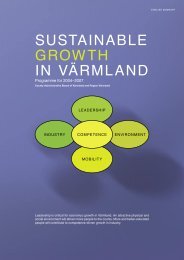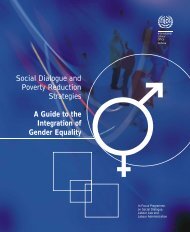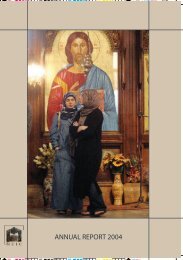PDF (222 KB) - Document Database website
PDF (222 KB) - Document Database website
PDF (222 KB) - Document Database website
You also want an ePaper? Increase the reach of your titles
YUMPU automatically turns print PDFs into web optimized ePapers that Google loves.
ACHIEVING THE LISBON GOALS<br />
THE CONTRIBUTION OF VOCATIONAL EDUCATION AND TRAINING IN ROMANIA<br />
<br />
<br />
<br />
<br />
Development of occupational and<br />
vocational training standards with the<br />
involvement of the social partners.<br />
Between 1995 and 2001 more than 300<br />
competency-based occupational<br />
standards have been developed that<br />
have been used for the definition of<br />
training standards. In addition, about<br />
221 training standards have been also<br />
developed, based on the occupational<br />
standards when these were available.<br />
The training standards include: core<br />
skills and specific skills, qualification<br />
levels, values of earned credits,<br />
performance criteria and instructions as<br />
to their applicability, and assessment<br />
tests. The training standards have been<br />
subject to a validation process by the<br />
representatives of the social partners,<br />
and are available to any VET provider.<br />
Conditions have also been created for<br />
the application of similar standards to<br />
CVT, defining framework curricula, but<br />
to what extent the training standards<br />
developed for IVET can also be used for<br />
CVT remains an issue.<br />
Recognition and harmonisation of<br />
the levels of vocational<br />
qualifications. Romanian vocational<br />
qualifications are based on the<br />
European five-level framework as<br />
defined in Council Decision of<br />
85/368/EEC. The qualification levels<br />
from 1 to 3 have been recognised and<br />
used accordingly. The use of level 4<br />
and 5 qualifications is hampered by the<br />
fact that only universities are allowed to<br />
issue them; hence, these levels are not<br />
yet widely used, although they are<br />
embedded in the legislation. These<br />
higher levels will be identified in the next<br />
stage of the reform programme.<br />
Correlation of qualification levels in<br />
the vocational and technical<br />
education systems, promoting<br />
progression towards a level 3<br />
qualification. There exists the option to<br />
obtain the level 2 and 3 qualifications<br />
successively through the Arts and<br />
Trades Schools, following the<br />
complementary school year that leads<br />
to level 1.<br />
Development of a Romanian National<br />
System of Vocational Qualifications.<br />
During 2003/04 the basic steps have<br />
been laid down in the development of a<br />
Romanian National System of<br />
Vocational Qualifications (NSVQ). This<br />
should integrate formal and non-formal<br />
learning, TVET and CVT. The policy<br />
principles for the system have been<br />
agreed between the government and<br />
social partners, and legislation is being<br />
prepared.<br />
Introduction of new curricula, core skills<br />
and learning methodologies<br />
The changes carried out in the TVET<br />
system in the framework of the Phare<br />
TVET RO 0108.2001 programme (which<br />
began in 2003) were directed towards the<br />
development of an innovative curriculum.<br />
These innovations are a continuation of<br />
changes started by the Phare VET<br />
RO-9405 programme (which ran between<br />
1995 and 1998), and are strongly<br />
influenced by the new regulations on the<br />
extension of compulsory education to 10<br />
years.<br />
<br />
<br />
Tree structure based on broader<br />
profiles. Starting from the training<br />
standards, the written curriculum<br />
(school curriculum and programmes)<br />
was designed by the programme<br />
management of the Phare 9405<br />
programme and developed by<br />
vocational boards established according<br />
to occupational families. Curriculum<br />
units were organised based on the<br />
following principles: the organisation of<br />
activities by study modules that ensure<br />
a passage from basic training (first year)<br />
to general training (second year) and<br />
finally to special profile training (third<br />
year of study); making vocational<br />
training more flexible by offering the<br />
option of changing the order in which<br />
study modules are taken, and<br />
introducing new knowledge in the<br />
context of continuous adjustment to<br />
educational needs; and modernising the<br />
system of evaluation.<br />
System-wide implementation<br />
commenced. In 1999 the new<br />
curriculum structure that was developed<br />
under the Phare RO-9405 programme<br />
began to be implemented beyond the<br />
network of 75 pilot schools. The lack of<br />
appropriate conditions and resources in<br />
many TVET schools, as well as<br />
16








